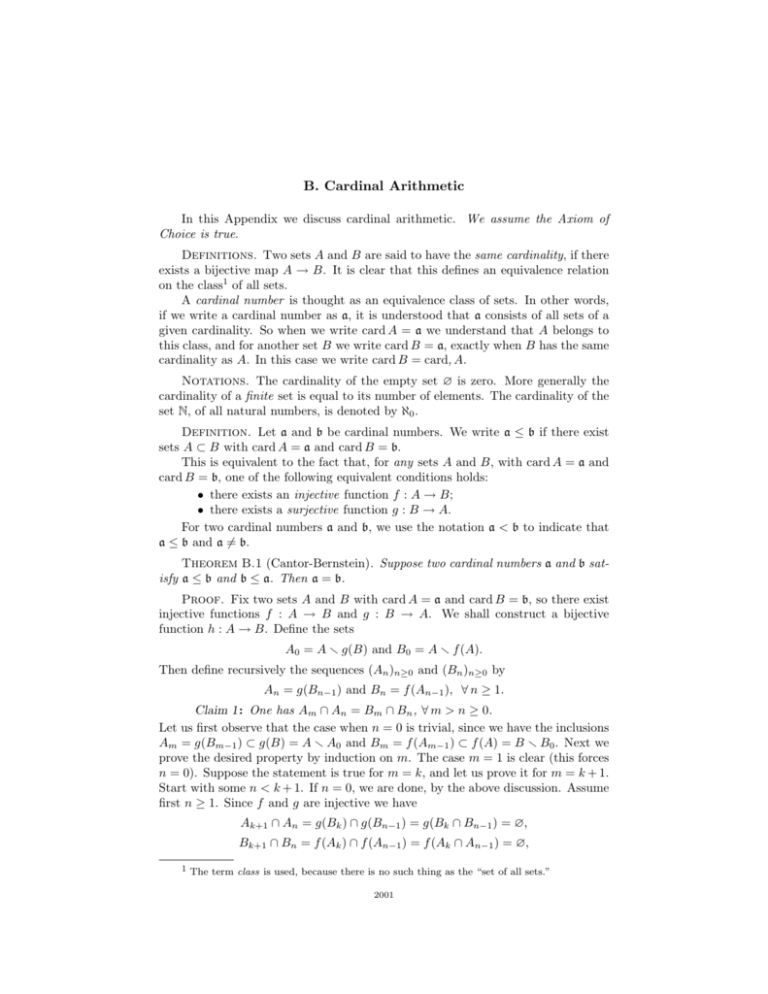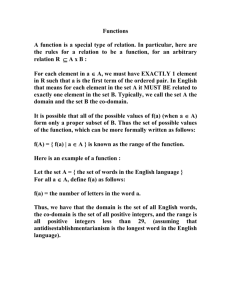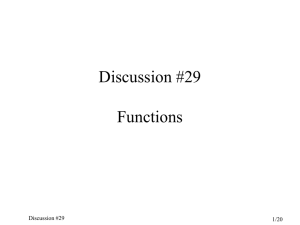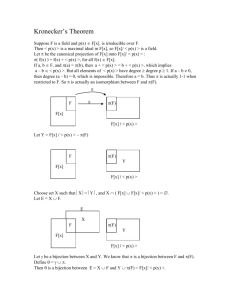B. Cardinal Arithmetic
advertisement

B. Cardinal Arithmetic
In this Appendix we discuss cardinal arithmetic. We assume the Axiom of
Choice is true.
Definitions. Two sets A and B are said to have the same cardinality, if there
exists a bijective map A → B. It is clear that this defines an equivalence relation
on the class1 of all sets.
A cardinal number is thought as an equivalence class of sets. In other words,
if we write a cardinal number as a, it is understood that a consists of all sets of a
given cardinality. So when we write card A = a we understand that A belongs to
this class, and for another set B we write card B = a, exactly when B has the same
cardinality as A. In this case we write card B = card, A.
Notations. The cardinality of the empty set ∅ is zero. More generally the
cardinality of a finite set is equal to its number of elements. The cardinality of the
set N, of all natural numbers, is denoted by ℵ0 .
Definition. Let a and b be cardinal numbers. We write a ≤ b if there exist
sets A ⊂ B with card A = a and card B = b.
This is equivalent to the fact that, for any sets A and B, with card A = a and
card B = b, one of the following equivalent conditions holds:
• there exists an injective function f : A → B;
• there exists a surjective function g : B → A.
For two cardinal numbers a and b, we use the notation a < b to indicate that
a ≤ b and a 6= b.
Theorem B.1 (Cantor-Bernstein). Suppose two cardinal numbers a and b satisfy a ≤ b and b ≤ a. Then a = b.
Proof. Fix two sets A and B with card A = a and card B = b, so there exist
injective functions f : A → B and g : B → A. We shall construct a bijective
function h : A → B. Define the sets
A0 = A r g(B) and B0 = A r f (A).
Then define recursively the sequences (An )n≥0 and (Bn )n≥0 by
An = g(Bn−1 ) and Bn = f (An−1 ), ∀ n ≥ 1.
Claim 1: One has Am ∩ An = Bm ∩ Bn , ∀ m > n ≥ 0.
Let us first observe that the case when n = 0 is trivial, since we have the inclusions
Am = g(Bm−1 ) ⊂ g(B) = A r A0 and Bm = f (Am−1 ) ⊂ f (A) = B r B0 . Next we
prove the desired property by induction on m. The case m = 1 is clear (this forces
n = 0). Suppose the statement is true for m = k, and let us prove it for m = k + 1.
Start with some n < k + 1. If n = 0, we are done, by the above discussion. Assume
first n ≥ 1. Since f and g are injective we have
Ak+1 ∩ An = g(Bk ) ∩ g(Bn−1 ) = g(Bk ∩ Bn−1 ) = ∅,
Bk+1 ∩ Bn = f (Ak ) ∩ f (An−1 ) = f (Ak ∩ An−1 ) = ∅,
1 The term class is used, because there is no such thing as the “set of all sets.”
2001
2002
APPENDICES
and we are done.
S
Put C = A rn≥0 An and D = B r n≥0 Bn .
Claim 2: One has the equality f (C) = D.
First we prove the inclusion f (C) ⊂ D. Start with some point c ∈ C, but assume
f (c) 6∈ D. This means that there exists some n ≥ 0 such that f (c) ∈ Bn . Since
f (c) ∈ f (A) = B rB0 , we must have n ≥ 1. But then we get f (c) ∈ Bn = f (An−1 ),
and the injectivity of f will force c ∈ An−1 , which is impossible.
Second, we prove that D ⊂ f (C). Start with some d ∈ D. First of all, since
D ⊂ B r B0 = f (A), there exists some c ∈ A with d = f (c). If c 6∈ C, then there
exists some n ≥ 0, such that c ∈ An , and then we would get d = f (c) ∈ f (An ) =
Bn+1 , which is impossible.
S
We now begin constructing the desired bijection. First we define φ : n≥0 Bn →
B by
b
if b ∈ Bn and n is odd
φ(b) =
(f ◦ g)(b) if b ∈ Bn and n is even
Claim 3: The map φ defines a bijection
[
[
φ:
Bn →
Bn .
n≥0
n≥1
It is clear that, since φBn is injective, the map φ is injective. Notice also that, if
n ≥ 0 is even, then φ(Bn ) = f g(Bn ) = f (An+1 ) = Bn+2 . When n ≥ 0 is odd we
have φ(Bn ) = Bn , so we have indeed the equality
[
[
φ
Bn .
Bn =
n≥0
n≥1
Now we define ψ : n≥0 An → B by ψ = φ−1 ◦ f . Clearly ψ is injective, and
[
[
[
[
[
ψ
An = φ−1
f (An ) = φ−1
Bn+1 = φ−1
Bn =
Bn ,
S
n≥0
n≥0
n≥0
n≥1
n≥0
so ψ defines a bijection
ψ:
[
n≥0
An →
[
Bn .
n≥0
We then combine ψ with the bijection f : C → D, i.e. we define the map h : A → B
by
S
ψ(x) if x ∈ n≥0 An
S
h(x) =
f (x) if x ∈ A r n≥0 An = C.
Clearly h is injective, and
h(B) = ψ
[
n≥0
so h is indeed bijective.
An ∪ f (C) =
[
Bn ∪ D = B,
n≥0
Theorem B.2 (Total ordering for cardinal numbers). Let a and b be cardinal
numbers. Then one has either a ≤ b, or b ≤ a.
Proof. Choose two sets A and B with card A = a and card B = b. In order to
prove the theorem, it suffices to construct either an injective function f : A → B,
or an injective function f : B → A.
B. Cardinal Arithmetic
2003
We define the set
X = {(C, D, g) : C ⊂ A, D ⊂ B, g : C → D bijection}.
We equip X with the following order relation:
C ⊂ C0
0
0 0
D ⊂ D 0
(C, D, g) ≺ (C , D , g ) ⇐⇒
g = g0 C
We now check that (X, ≺) satisfies the
hypothesis of Zorn
Lemma. LetSA ⊂ X
be a totally
ordered
subset,
say
A
=
(C
,
D
,
g
)
:
i
∈
I
. Define C = i∈I Ci ,
i
i
i
S
D = i∈I Di , and g : C → D to be the unique function with the property that
g C = gi , ∀ i ∈ I. (We use here the fact that for i, j ∈ I we either have Ci ⊂ Cj
i
and gj C = gi , or Cj ⊂ Ci and gi C = gj . In either case, this proves that
i
j
gi = gj , ∀ i, j ∈ I, so such a g exists.) It is then pretty clear that
Ci ∩Cj
Ci ∩Cj
(C, D, g) ∈ X and (Ci , Di , gi ) ≺ (C, D, g), ∀ i ∈ I, i.e. (C, D, g) is an upper bound
for A. Use now Zorn Lemma, to find a maximal element (A0 , B0 , f ) in X.
Claim: Either A0 = A or B0 = B.
We prove this by contradiction. If we have strict inclusions A0 ( A and B0 ( B,
then if we choose a ∈ A r A0 and b ∈ B r B0 , we can define a bijection g :
A0 ∪ {a} → B0 ∪ {b0 } by g(a) = b and g A0 = f . This would then produce a
new element (A0 ∪ {a}, B0 ∪ {b}, g) ∈ X, which would contradict the maximality of
(A0 , B0 , f ).
The theorem now follows immediately from the Claim. If A0 = A, then f :
A → B is injective, and if B0 = B, then f : B → A is injective.
We now define the operations with cardinal numbers.
Definitions. Let a and b be cardinal numbers.
• We define a+b = card S, where S is any set which is of the form S = A∪B
with card A = a, card B = b, and A ∩ B = ∅.
• We define a·b = card P , where P is any set which is of the form P = A×B
with card A = a and card B = b.
• We define ab = card X, where X is any set of the form X which is of the
form
Y
X=
Ai ,
i∈I
with card I = b and card Ai = a, ∀ i ∈ I. Equivalently, if we take two sets
A and B with card A = a, and card B = b, and if we define
Y
AB =
A = {f : f function from B to A},
B
then ab = card(AB ).
It is pretty easy to show that these definitions are correct, in the sense that they
do not depend on the particular choices of the sets involved. Moreover, these
operations are consistent with the usual operations with natural numbers.
Remark B.1. The operations with cardinal numbers, defined above, satisfy:
• a + b = b + a,
• (a + b) + d = a + (b + d),
2004
APPENDICES
•
•
•
•
•
•
•
•
a + 0 = a,
a · b = b · a,
(a · b) · d = a · (b · d),
a · 1 = a,
a · (b + d) = (a · b) + (a · d),
(a · b)d = (ad ) · (bd ),
ab+d = (ab ) · (ad ),
(ab )d = (ab·d ,
for all cardinal numbers a, b, d ≥ 1.
Remark B.2. The order relation ≤ is compatible with all the operations, in
the sense that, if a1 , a2 , b1 , and b2 are cardinal numbers with a1 ≤ a2 and b1 ≤ b2 ,
then
• a 1 + b1 ≤ a 2 + b2 ,
• a 1 · b 1 ≤ a 2 · b2 ,
• ab1 1 ≤ ab2 2 .
Proposition B.1. Let a ≥ 1 be a cardinal number.
(i) If A is a set with card A = a, and if we define
P(A) = {B : B subset of A},
then 2a = card P(A).
(ii) a < 2a .
Proof. (i). Put
P = {0, 1}A = f : f function from A to {0, 1} ,
so that 2a = card P . We need to define a bijection φ : P → P(A). We take
φ(f ) = {a ∈ A : f (a) = 1}, ∀ f ∈ P.
It is clear that, since a function f : A → {0, 1} is completely determined by the set
{a ∈ A : f (a) = 1}, the map φ is indeed bijective.
(ii). The map A 3 a 7−→ {a} ∈ P(A) is clearly injective. This prove the
inequality a ≤ 2a . We now prove that a 6= 2a , by contradiction. Assume there is a
bijection θ : A → P(A). Define the set
B = {a ∈ A : a 6∈ θ(a)},
and choose b ∈ A such that B = θ(b). If b ∈ B, then by construction we get
b 6∈ θ(b) = B, which is impossible. If b 6∈ B, we have b 6∈ θ(b), which forces b ∈ B,
again an impossibility.
We now discuss the properties of these operations, when infinite cardinal numbers are used.
Lemma B.1 (Properties of ℵ0 ).
(i) For any infinite cardinal number a, one has the inequality ℵ0 ≤ a.
(ii) ℵ0 + ℵ0 = ℵ0 ;
(iii) ℵ0 · ℵ0 = ℵ0 ;
B. Cardinal Arithmetic
2005
Proof. (i). Let a be an infinite cardinal number, and let A be an infinite
set A, with card A = a. Since for every finite subset F ⊂ A, there exists some
x ∈ A r F , one to construct a sequence (xn )n∈N ⊂ A, with xm 6= xn , ∀ m > n ≥ 1.
Then the subset B = {xn : n ∈ N} has card B = ℵ0 , so the inclusion B ⊂ A gives
the desired inequality.
(ii). Consider the sets
A0 = {n ∈ N : n, even} and A1 = {n ∈ N : n, odd}.
Then clearly card A0 = card A1 = ℵ0 , and the equality A0 ∪ A1 = N gives
ℵ0 + ℵ0 = card A0 + card A1 = card(A0 ∪ A1 ) = card N = ℵ0 .
(iii). Take the set P = N × N, so that ℵ0 · ℵ0 = card P . It is obvious that
card P ≥ ℵ0 . To prove the other inequality, we define a surjection φ : N → P as
follows. For each n ≥ 1 we take sn = n(n − 1)/2, we set
Bn = {m ∈ N : sn < m ≤ sn+1 },
and we define φn : Bn → P by
φ(m) = (n + sn − m, m − sn + 1), ∀ m ∈ Bn .
Notice that
φn (Bn ) = {(p, q) ∈ N × N : p + q = n + 1}.
(1)
S
Notice also that n≥1 Bn = N, and Bj ∩ Bk = ∅, ∀ j > k ≥ 1, so there exists a
(unique) function φ : N → P , such that φB = φn , for all n ≥ 1. By (1) it is clear
n
that φ is surjective.
Theorem B.3. Let a and b be cardinal numbers, with 1 ≤ b ≤ a, and a infinite.
Then:
(i) a + b = a;
(ii) a · b = a.
Proof. It is clear that
a ≤ a + b ≤ a + a,
a ≤ a · b ≤ a · a,
so in order to prove the theorem, we can assume that a = b.
(i). Fix some set A with card A = a. Use Zorn Lemma, to find a maximal
non-empty family {Ai : i ∈ I} of subsets of A with
(a) card Ai = ℵ0 , for all i, j ∈ I;
(b) Ai ∩ Aj = ∅, for all i, j ∈ I with i 6= j.
S
If we put B = A r
i∈I Ai , then by maximality it follows that B is finite. In
particular, if we take i0 ∈ I then obviously card(Ai0 ∪ B) = ℵ0 , so if we replace
Ai0 with
S Ai0 ∪ B, we will still have the above properties (a) and (b), but also
A = i∈I Ai . This proves that a = card A = ℵ0 · d, where d = card I. In other
words, we have a = card(N × I). Consider then the sets
C0 = {n ∈ N : n even} and C1 = {n ∈ N : n odd},
2006
APPENDICES
so that (C0 × I) ∪ (C1 × I) = I × N, and (C0 × I) ∩ (C1 × I) = ∅. In particular,
we get
a = card(C0 × I) + card(C1 × I) =
= (card C0 ) · (card I) + (card C1 ) · (card I) =
= ℵ0 · d + ℵ0 · d = a + a.
(ii). Fix A a set with card A = a. We are going to employ Zorn Lemma to find
a bijection A → A × A. Define
X = (D, f ) : D ⊂ A, f : D → D × D bijective .
Equip X with the following order
(D, f ) ≺ (D0 , f 0 ) ⇐⇒
D ⊂ D0
f = f 0 D
Notice that X is non-empty, since we can find at leas one set D ⊂ A with card D =
ℵ
that X satisfies the hypothesis of Zorn Lemma. Let T =
0 . We now check
(Di , fi ) : i ∈ I be a totally ordered subset of X. It is fairly clear that if one
takes
S
D = i∈I and one defines f : D → D × D as the unique function with f D = fi ,
i
∀ i ∈ I, then f is injective, and
[
[
[
f (D) =
f (Di ) =
fi (Di ) =
(Di × Di ) = D × D,
i∈I
i∈I
i∈I
so the pair (D, f ) indeed belongs to X, and is an upper bound for T.
Use Zorn Lemma to produce a maximal element (D, f ) ∈ X. Notice that, if we
take d = card D, then by construction we have
(2)
d · d = d.
We would like to prove that D = A. In general this is not the case (for example,
when A = N, every (D, f ) ∈ X, with N r D finite, is automatically maximal). We
notice however that all we need to show is the equality
(3)
d = a.
We prove this equality by contradiction. We know that we already have d ≤ a.
Suppose d < a. Put G = A r D notice that d + card G = a. Since d < a, by (i) we
see that we must have the equality card G = a. Then there exists a subset E ⊂ G
with card E = d. Consider the set
P = (E × E) ∪ (E × D) ∪ (D × E).
Since E ∩ D = ∅, the three sets above are pairwise disjoint, so using (2) combined
again with part (i), we get
card P = card(E × E) + card(E × D) + card(D × E) =
= d · d + d · d + d · d = d + d + d = d = card E.
This means that there exists a bijection g : E × P , which combined with the fact
that E ∩ D = P ∩ (D × D)
= ∅, will produce a bijection h : D ∪ E → P ∪ (D × D),
such that hD = f and hE = g. Since we have P ∪ (D × D) = (D ∪ E) × (D ∪ E),
the pair (D ∪ E, h) ∈ X will contradict the maximality of (D, f ).
B. Cardinal Arithmetic
2007
Corollary B.1. If a is an infinite cardinal number, and if b is a cardinal
number with 2 ≤ b ≤ 2a , then
ba = 2a .
Proof. We have
2a ≤ ba ≤ (2a )a = 2a·a = 2a ,
and the desired equality follows from the Cantor-Bernstein Theorem.
Corollary B.2. Let a be an infinite cardinal number, let A be a set with
card A = a, and define
Pfin (A) = {F ∈ P(A) : F finite}.
Then card Pfin (A) = a.
Proof. First of all, the map A 3 a 7−→ {a} ∈ Pfin (A) is injective, so a ≤
card Pfin (A).
We now prove the other inequality. For every integer n ≥ 1, let An denote the
n-fold cartesian product. We treat the sequence A1 , A2 , . . . as pairwise disjoint.
For every n ≥ 1 we define the map
φn : An → Pfin (A),
by
φ(a1 , . . . , an ) = {a1 , . . . , an },
S∞
n
and
we define the map φ : n=1 A → Pfin (A) as the unique map such that
φ An = φn , ∀ n ≥ 1. Notice now that, since
card An = an = a, ∀ n ≥ 1,
it follows that
card
∞
[
An = ℵ0 · a = a,
n=1
which gives
card(Range φ) ≤ a.
But it is clear that
{∅} ∪ Range φ = Pfin (A),
and the fact that Pfin (A) is infinite, proves that
card Pfin (A) = card(Range φ) ≤ a.
We conclude with a result on the cardinal number c = card R.
Proposition B.2.
(i) For two real numbers a < b, one has
card(a, b) = card[a, b) = card(a, b] = card[a, b] = c.
ℵ0
(ii) c = 2 .
2008
APPENDICES
Proof. (i). It is clear that, since (a, b) is infinite, we have
card[a, b] = 2 + card(a, b) = card(a, b).
The inclusions (a, b) ⊂ [a, b) ⊂ [a, b] and (a, b) ⊂ (a, b] ⊂ [a, b], combined with the
Cantor-Bernstein Theorem, immediately give
card[a, b) = card(a, b] = card(a, b).
Finally, the bijection
(a, b) 3 t 7−→ tan
π(2t − a − b)
2(b − a)
∈R
shows that card(a, b) = c.
(ii). The proof of this result uses a certain construction, which is useful for
many other purposes. Therefore we choose to work in full generality. Consider the
set
T = {0, 1}ℵ0 = a = (αn )n∈N : αn ∈ {0, 1}, ∀ n ∈ N ,
so 2ℵ0 = card P . For any real number r ≥ 2, we define the map φr : T → [0, 1] by
φ(a) = (r − 1)
∞
X
αn
, ∀ a = (αn )n∈N ∈ T.
rn
n=1
The maps φr , r ≥ 2 are “almost” injective. To clarify this, we define the set
T0 = a = (αn )n∈N ∈ T : the set {n ∈ N : αn = 0} is infinite .
Note that
T r T0 = (αn )n∈N ∈ T : there exists N ∈ N, such that αn = 1, ∀ n ≥ N .
Clearly φ is surjective. In fact φ is “almost” bijective.
Claim 1: Fix r ≥ 2. For elements a = (αn )n∈N , b = (βn )n∈N ∈ T0 , the
following are equivalent
(∗) φr (a) > φr (b);
(∗∗) there exists k ∈ N, such that alphak > βk , and αj = βj , for all j ∈ N
with j < k.
We first prove the implication (∗∗) ⇒ (∗). If a, b ∈ T0 satisfiy (∗∗), then
(4) φr (a) − φr (b) =
∞
∞
X
X
r−1
αn − βn
r−1
βn
+
(r
−
1)
≥
−
(r
−
1)
.
k
n
k
r
r
r
2n
n=k+1
n=k+1
Notice now that there are infinitely many indices n ≥ k + 1 such that βn = 0. This
gives the fact that
∞
∞
X
X
βn
1
1
<
=
,
rn
rn
(r − 1)rk
n=k+1
n=k+1
so if we go back to (4) we get
φr (a) − φr (b) ≥
∞
X
r−1
βn
r−1
1
r−2
−
(r
−
1)
> k − k = k ≥ 0,
k
n
r
r
r
r
r
n=k+1
so in particular we get φr (a) > φr (b.
Conversely, if φr (a) > φr (b), we choose
k = min{n ∈ N : αn 6= βn }.
B. Cardinal Arithmetic
2009
Using the implication (∗∗) ⇒ (∗) we see that we cannot have βk > αk , because this
would force φ(b) > φ(a). Therefore we must have αk > βk , and we are done.
Using Claim 1, we now see that φr T0 : T0 → [0, 1] is injective
Claim 2: card(T r T0 ) = ℵ0 .
This is pretty clear, since we can write
T r T0 =
∞
[
Rk ,
k=1
where
Rn = a = (αn )n∈N ∈ T : αn = 1, ∀ n ≥ 1 .
Since each Rn is finite, the desired result follows.
Using Claim 2, we have
2ℵ0 = card T = card(T r T0 ) + card T0 = ℵ0 + card T0 .
Since ℵ0 < 2ℵ0 , the above equality forces
2ℵ0 = card T0 .
For every r ≥ 2, we also have card φr (T rT0) ≤ ℵ0 , which then gives card φr (T )r
φr (T0 ) ≤ ℵ0 , hence using the injectivity of φr T , we have card φr (T0 ) = card T0 =
0
2ℵ0 , so we get
2ℵ0 = card φr (T0 ) ≤ card φr (T ) = card φr (T0 )+card φr (T )rφr (T0 ) ≤ card phir (T0 )+ℵ0 = 2ℵ0 +ℵ0 = 2ℵ0 .
By the Cantor-Bernstein Theorem this forces card φr (T ) = 2ℵ0 .
Now we are done, since for r = 2 we clearly have φ2 (T ) = [0, 1].
Corollary B.3.
(i) cℵ0 = c.
(ii) If we define the set
Pcount = {C ⊂ R : card F ≤ ℵ0 },
then card Pcount (R) = c.
Proof. (i). This is immediate from the equality 2ℵ0 = c and from Corollary
B.1.
(ii). Using the inclusion Pfin (R) ⊂ Pcount (R), combined with Corollary B.2, we
see that we have the inequality
c ≤ cardPcount (R).
To prove the other inequality, we define a map φ : RN → Pcount (R), as follows. If
a ∈ RN is a sequence, say a = (αn )n∈N , we put
φ(a) = {αn : n ∈ N}.
Since φ is clearly surjective, using part (i) we get
card Pcount (R) ≤ card RN = cℵ0 = c.








